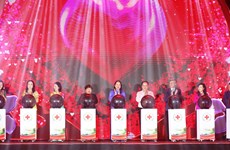Plan to preserve UNESCO heritage launched in Hanoi
The Ministry of Culture, Sports and Tourism on Jan. 22 launched an action plan to preserve the value of the Giong
festival, which has been recognised as an Intangible Cultural Heritage
of Humanity by the UNESCO.
The Ministry of Culture, Sports and Tourism on Jan. 22 launched a
national action plan to preserve and develop the value of the Giong
festival, which has been recognised as an Intangible Cultural Heritage
of Humanity by the UNESCO.
The plan was announced at a ceremony held in Phu Dong commune, Gia Lam district of Hanoi to receive the certificate of recognition of the UNESCO title.
At the ceremony, UNESCO Chief Representative in Hanoi Katherine Muller-Marin stressed that the Giong festival has been deeply impressed in the life of residents in the Red river delta as a part of their characteristics, passing from generations to generations. The recognition of the festival as an intangible cultural heritage of humanity is expected to accelerate humans’ creativeness and dialogues between cultures.
The ceremony was held in an open air of a northern countryside with an incense offering to Saint Giong at the beginning and then, the performances of ceremonies of the festival.
UNESCO officially honoured Vietnam’s Giong festival as an Intangible Cultural Heritage of Humanity at a meeting of its Inter-Governmental Committee in Nairobi, Kenya, on November 16, 2010.
The festival was Hanoi’s third heritage honour presented by the UNESCO in 2010.
The other sites include 82 steles engraved with names of doctorate holders for centuries in the Van Mieu-Quoc Tu Giam, Vietnam’s first university, which have been recognised as Documentary Heritage of the Memory of the World programme. The central site of the Thang Long Royal Citadel has won the title “World Cultural Heritage”.
The Giong festival is held annually in several parts of northern Vietnam, most typically in the Phu Dong and Soc Temples in Hanoi, to commemorate Saint Giong, one of the immortal quartets in the Vietnamese legends.
Legend has it that under the sixth King Hung’s reign (around 500 BC) Vietnam was threatened by the Kingdom of Yin, to the north of Vietnam.
A little boy, who was unable to crawl, roll over and say a single word at the age of three, had surprisingly grown up to a giant man in just several days after getting news on the foreign invasion. He used local bushes of bamboo to defeat aggressors and flew into the sky with his iron horse after the final victory.
In order to show their gratitude to the hero of Giong village, people proclaimed him Saint Giong.
The festival meets all qualifications for an intangible cultural heritage of humanity as it has been conserved by the community as part of the national cultural identity, handed down from generations to generations, holds creativeness of humanity and represents aspiration for prosperity by every family and peace for the nation and the world./.
The plan was announced at a ceremony held in Phu Dong commune, Gia Lam district of Hanoi to receive the certificate of recognition of the UNESCO title.
At the ceremony, UNESCO Chief Representative in Hanoi Katherine Muller-Marin stressed that the Giong festival has been deeply impressed in the life of residents in the Red river delta as a part of their characteristics, passing from generations to generations. The recognition of the festival as an intangible cultural heritage of humanity is expected to accelerate humans’ creativeness and dialogues between cultures.
The ceremony was held in an open air of a northern countryside with an incense offering to Saint Giong at the beginning and then, the performances of ceremonies of the festival.
UNESCO officially honoured Vietnam’s Giong festival as an Intangible Cultural Heritage of Humanity at a meeting of its Inter-Governmental Committee in Nairobi, Kenya, on November 16, 2010.
The festival was Hanoi’s third heritage honour presented by the UNESCO in 2010.
The other sites include 82 steles engraved with names of doctorate holders for centuries in the Van Mieu-Quoc Tu Giam, Vietnam’s first university, which have been recognised as Documentary Heritage of the Memory of the World programme. The central site of the Thang Long Royal Citadel has won the title “World Cultural Heritage”.
The Giong festival is held annually in several parts of northern Vietnam, most typically in the Phu Dong and Soc Temples in Hanoi, to commemorate Saint Giong, one of the immortal quartets in the Vietnamese legends.
Legend has it that under the sixth King Hung’s reign (around 500 BC) Vietnam was threatened by the Kingdom of Yin, to the north of Vietnam.
A little boy, who was unable to crawl, roll over and say a single word at the age of three, had surprisingly grown up to a giant man in just several days after getting news on the foreign invasion. He used local bushes of bamboo to defeat aggressors and flew into the sky with his iron horse after the final victory.
In order to show their gratitude to the hero of Giong village, people proclaimed him Saint Giong.
The festival meets all qualifications for an intangible cultural heritage of humanity as it has been conserved by the community as part of the national cultural identity, handed down from generations to generations, holds creativeness of humanity and represents aspiration for prosperity by every family and peace for the nation and the world./.












